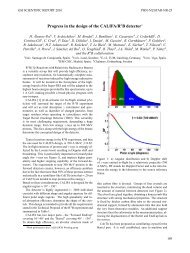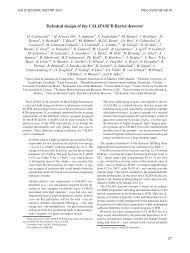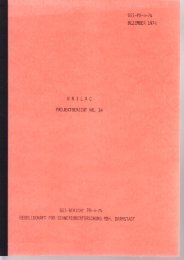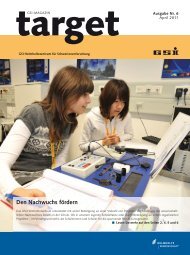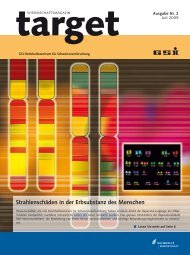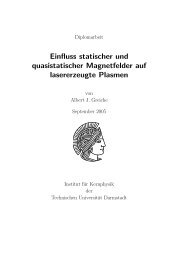download block - GSI Helmholtzzentrum für Schwerionenforschung
download block - GSI Helmholtzzentrum für Schwerionenforschung
download block - GSI Helmholtzzentrum für Schwerionenforschung
Create successful ePaper yourself
Turn your PDF publications into a flip-book with our unique Google optimized e-Paper software.
<strong>GSI</strong>-UPGRADE-ACC-05 <strong>GSI</strong> SCIENTIFIC REPORT 2009<br />
Measurement of the Longitudinal Phase Space at UNILAC<br />
To deliver the required currents for FAIR an important<br />
goal is to improve the matching into the Alvarez section of<br />
the UNILAC. Besides simulated phase space data, crucial<br />
information about the beam parameters is provided by diagnostic<br />
devices. While there are several standard methods<br />
to access the four-dimensional transverse phase space information,<br />
the longitudinal degree of freedom is as important<br />
but an unequally more demanding measurement task.<br />
The current approach is based on the time-of-flight<br />
(TOF) measurement of single particles between two detectors<br />
(see Fig. 1), and constructing the longitudinal phase<br />
space via 2-dim histogramming using the arrival times at<br />
both detectors and UNILAC rf reference [1]. The energy<br />
information is extracted from the TOF between a MCP and<br />
a diamond detector, whereas the arrival time at the diamond<br />
with respect to the rf serves as a direct measure of the relative<br />
phase location between particles. Imposed by the limited<br />
distance (800 mm) between these detectors, a time resolution<br />
of only several tens of picoseconds is mandatory to<br />
resolve an rms energy spread of about 1% at 1.4 MeV/u.<br />
The TDC and discriminators are capable to provide a time<br />
resolution of about 50 ps rms. Additionally, signals from<br />
the diamond and MCP suffer from a broad pulse height<br />
spectrum and varying pulse shapes that significantly degrade<br />
time resolution.<br />
While the vertical projection of the longitudinal phase<br />
space distribution yields trustworthy bunch structure information,<br />
the limited energy resolution affects the measured<br />
size of the phase space, which results in an enlarged<br />
emittance ε and decreased covariance. Therefore<br />
the related correlation � �as<br />
described by the Twiss param-<br />
∆E<br />
eter α = −cov 〈E〉 , t /ε is smaller than expected from<br />
simulations and a plausible machine operation mode. To<br />
3<br />
Coulomb<br />
scattering at<br />
thin Ta target Collimator<br />
Gating Discriminators Amps<br />
Anode<br />
50<br />
T. Milosic 1 , P. Forck 1 , and D. Liakin 1,2<br />
1 <strong>GSI</strong>, Darmstadt, Germany; 2 ITEP, Moscow, Russia<br />
MCP<br />
2<br />
e -<br />
Diamond<br />
detector<br />
poly cryst.<br />
S 1<br />
Thin Al Al foil<br />
Figure 1: Single particles are detected indirectly at the<br />
MCP module (2) and directly at the diamond detector (1)<br />
whereas the UNILAC rf serves as timing reference (3).<br />
150<br />
Relative Energy Deviation<br />
Relative Energy Deviation<br />
0.08<br />
0.06<br />
0.04<br />
0.02<br />
0<br />
-0.02<br />
-0.04<br />
-0.06<br />
-0.08<br />
0.08<br />
0.06<br />
0.04<br />
0.02<br />
0<br />
-0.02<br />
-0.04<br />
-0.06<br />
-0.08<br />
a)<br />
Original Data (60k Events)<br />
-6 -4 -2 0 2 4 6<br />
Arrival time at Diamond detector [ns]<br />
-6 -4 -2 0 2 4 6<br />
Arrival time at Diamond detector [ns]<br />
[Twiss Parameter]<br />
α<br />
Correlation<br />
Relative Energy Deviation<br />
2.5<br />
2<br />
1.5<br />
1<br />
0.5<br />
0.08<br />
0.06<br />
0.04<br />
0.02<br />
0<br />
-0.02<br />
-0.08<br />
Original Data<br />
Vertical Fit<br />
Deconvolved<br />
10 20 30 40 50 60 70 80 90<br />
Cutoff [% Integral Intensity]<br />
Vertical Gauss Fit<br />
-0.04<br />
-0.06 Analytic Deconvolution<br />
d)<br />
b) c)<br />
-6 -4 -2 0 2 4 6<br />
Arrival time at Diamond detector [ns]<br />
Figure 2: a) Plain data from DAQ. b) Reconstructed phase<br />
space using Gaussian fits to energy degree of freedom.<br />
c) Analytic deconvolution with σi,dec =<br />
�<br />
σ 2 i,fit − σ2 res<br />
for each vertical slice i (see text). d) Correlation α for<br />
original, fitted and deconvolved phase space vs. integral<br />
cutoff levels.<br />
improve the systematic energy broadening, deconvolution<br />
methods were investigated in order to disentangle the error<br />
contribution from the original phase space data. In Fig. 2<br />
an example of the original and deconvoluted data is shown<br />
from a high current Argon beam (6.5 mA) recorded during<br />
the HIPPI campaign at <strong>GSI</strong> [2]. Statistical noise, off-center<br />
vagabonding particles and the intrinsic low count rates are<br />
severe issues concerning a deconvolution approach. Furthermore,<br />
no pulse response is available from experimental<br />
data due to the lack of a monochromatic beam. Thus<br />
the pulse response is deduced from a consideration of error<br />
contribution based on a Gaussian model denoted by σres.<br />
This permits us to perform an analytic deconvolution of the<br />
energy information when vertical slices are also fitted with<br />
an Gaussian parameterization as depicted in Fig. 2. A consistent<br />
deconvolution of the energy distribution is achieved<br />
even for noisy data. Moreover, the correlation α changes<br />
significantly and approaches the expected value.<br />
As an alternative to the TOF measurement preliminary<br />
investigations of the calorimetric properties of a monocrystalline<br />
diamond detector have been performed using an<br />
Am-243 source. Preliminary analysis shows an energy resolution<br />
of about 1% for α particles at several MeV. The<br />
detector has been installed and will be tested soon.<br />
References<br />
[1] T. Milosic, P. Forck, D. Liakin, “Longitudinal Emittance<br />
Measurement using Particle Detectors”, DIPAC’09, Basel,<br />
May 2009, p. 330.<br />
[2] High Intensity Pulsed Proton Injectors (HIPPI), Joint Research<br />
Activity (JRA3) in the framework of CARE.





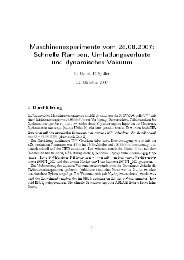
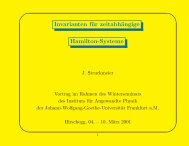
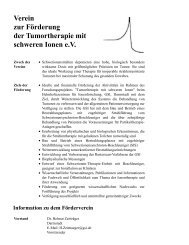
![GS I -P-]-17 - GSI Helmholtzzentrum für Schwerionenforschung](https://img.yumpu.com/20698964/1/184x260/gs-i-p-17-gsi-helmholtzzentrum-fur-schwerionenforschung.jpg?quality=85)

